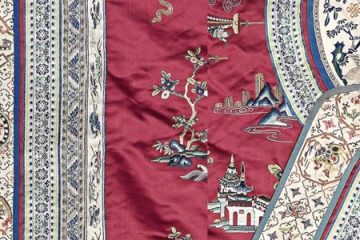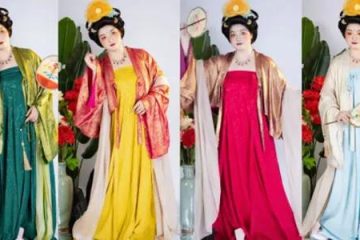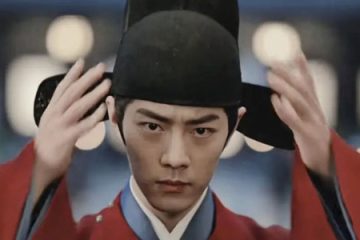Why Do People Still Wear Long Sleeves in Hot Lingnan?

The historical drama The Litchi Road has just been released across major streaming platforms. Interestingly, this story has already been adapted into a film, a stage play, and now a TV series—creating what fans are calling the “Chang’an Universe.”
In the drama, the character Li Shande is sent on a mission to deliver fresh lychees from Lingnan to the emperor. Viewers with a sharp eye have noticed something curious: although the show portrays Lingnan as unbearably hot—with characters constantly sweating—almost everyone, except for Governor He, is still wearing long sleeves. Aren’t they burning up?
In this post, let’s dive into a fun and informative look at why long sleeves hanfu were the norm, even in the sweltering heat. Curious? Keep reading!
Ⅰ. Where Exactly Is Lingnan?
Time for a little background! In ancient and modern terms, Lingnan refers to the region that includes today’s Guangdong, Guangxi, northern Vietnam, and Hainan. Geographically, this area lies in the southernmost part of China—hot, humid, and historically known for being full of natural obstacles like swamps, dense forests, and disease-carrying mists. For centuries, it was viewed as a wild and inhospitable land.
In fact, being exiled to Lingnan was often considered a harsh punishment. It was typically reserved for criminals or political outcasts. One of China’s most famous poets, Su Shi (also known as Su Dongpo), was exiled there for years.
He once wrote,
“Perhaps Heaven sees me as a modern-day Jizi, sent to this distant place to fulfill a mission.”
In this line, Su Shi compares himself to Jizi—a historical figure known for offering wise counsel to rulers, who was also eventually exiled. Like Jizi, Su Shi tried to speak truth to power and paid the price.
Regardless of the poetic metaphors, one thing is clear: Lingnan was seen as remote, rugged, and rough—a place people were sent to, not a place they willingly chose.

Ⅱ. What Did People Wear Back Then?
Let’s get back on track. During most of the Tang Dynasty, the climate in Lingnan was actually even hotter than it is today—some scholars estimate it was about 1–2°C (roughly 2–4°F) warmer than modern times. So why were people still wearing long sleeves?

There were a few good reasons. First, long sleeves were part of formal dress code and etiquette, especially in public or official settings. It simply wasn’t appropriate to show up in short sleeves for serious matters.
Second, while the Chinese dresses were long-sleeved, they were made from natural materials like linen or lightweight silk, which were breathable and far more comfortable than modern synthetic fabrics. And finally, those long sleeves and pants provided a practical benefit—they helped protect against mosquito bites and other insect troubles common in subtropical regions.
As we’ve explained before, the short-sleeved robes worn by characters like Prefect He were typically used as inner layers beneath a long outer robe. Someone walking around in just a short-sleeved garment would usually be at home or in an informal situation. So, while it might seem strange to us now, long sleeves in the blazing Lingnan heat made a lot more sense back then than you’d think!

And of course, people doing heavy labor—like porters who had to carry loads or anyone doing physically demanding work—would often sweat a lot. To stay cool and keep their sleeves out of the way, they’d roll them up, wear robes half open, or even go with sleeveless or short-sleeved garments.
The same goes for soldiers or anyone on horseback practicing archery—loose sleeves could easily get in the way or wear out quickly from all the movement, so practical, less restrictive clothing was the smart choice for them.

Ⅲ. Why Long Sleeves in the Heat?
So, why did people insist on wearing long sleeves even in sweltering weather? Aside from formal dress codes, there were practical reasons too.
1. Protects against mosquitoes and sunburn
Lingnan has a long, humid summer season, and in ancient times, the area was notorious for its outbreaks of disease—especially malaria, often referred to simply as “miasma” back then. The local saying even went, “In the South, all illness is called miasma.” Since malaria is spread by mosquitoes, long sleeves and pants were actually a form of protection—kind of like the ancient version of bug-repellent clothing.
Plus, long sleeves offered solid sun protection, just like today’s lightweight UV-blocking shirts. So while it might seem uncomfortable, it was actually the smartest and safest way to dress in that climate.

2. Lightweight Fabrics
Even though they wore long sleeves, it wasn’t as stifling as you might imagine. That’s because the materials were surprisingly lightweight and breathable. Take ramie, for example—a plant-based fiber similar to linen. While we might think of it as a simple, everyday fabric, in ancient China it could be refined to noble levels. Skilled craftsmanship made even common textiles look elegant and luxurious.
Not all ramie was created equal, though. The highest-quality kind was prized for being
“As light as a cicada’s wing and thin as rice paper.”
There’s even an old poem called Jin Bailu Dance Song and Poem (《晋白纻舞歌诗》) from the Jin dynasty that praises its beauty, saying it was “soft as drifting clouds and bright as silver.” Whether for commoners or aristocrats, these airy, natural fabrics helped people stay cool while still dressing with style and grace.

Another popular summer fabric in ancient China was 葛纱 (géshā)—a lightweight gauze made from ramie. It was known for its natural cooling effect, far more breathable and comfortable than modern synthetic fabrics.
A great example comes from the poet Du Fu, who was 39 and waiting for a government post at the imperial academy. On the Dragon Boat Festival, he unexpectedly received a gift from the emperor: a robe made of ramie gauze. He was so moved by this honor that he wrote a poem about it, titled “Clothing Gifted on the Dragon Boat Festival.” In it, he praises the garment as:
“Fine ramie soft in the breeze, fragrant silk light as drifting snow…
Wearing it in summer brings coolness… I’ll remember this imperial favor forever.”
Clearly, even in the heat of summer, traditional long-sleeved clothing could be both elegant and practical—especially when made from fabrics designed to beat the heat.

So even when ancient people had to layer up in public with long sleeves, they often chose lightweight, breathable fabrics to stay comfortable. It wasn’t the heavy, suffocating image we might imagine today.
Women, for example, might wear a sheer, cross-collared outer robe that offered just a glimpse of skin—both elegant and airy. Plus, those long sleeves weren’t just for looks; they also helped protect joints from dampness and humidity.
In the end, it just goes to show—ancient fashion was a lot smarter and more practical than we often give it credit for.

Summary
So, after all that—are you still wondering how people in Tang Dynasty Lingnan could stand wearing long sleeves in the heat? 😄
Sure, it was hot, but thanks to clever fabric choices and practical design, some summer hanfu were surprisingly breathable—and even good for their health in some ways!
Now that summer’s in full swing, how’s the weather where you are? Drop a comment and let’s chat about it!



0 Comments